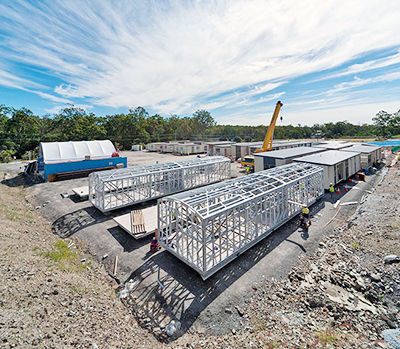‘Prefab’ metamorphosis for construction
RESEARCH Construction Skills Queensland (CSQ) and Australia’s scientific agency, the CSIRO, sees the construction industry being transformed by prefabrication and modular housing over the next two decades.
The combined report, named The Farsight Project, reveals that new technologies will cause a major shift in the way houses and buildings are constructed.
According to the Manufacturing Excellence Taskforce of Australia, modular buildings today make up $4.6 billion (or 3 percent) of Australia’s annual $150 billion construction industry. 
CSQ director for evidence and data, Robert Sobyra, said this figure would increase significantly as building companies embrace the cost and time-saving benefits of operating in a controlled building environment.
“Working in a factory takes a lot of the risk out of building,” Mr Sobyra said. “There are no delays due to bad weather, more efficient processes can be used, and construction can occur at any time of day.
“Automated construction technology is well suited to modular building styles and may bring costs down further. Modular buildings are constructed in a very structured, pre-defined way. This sort of predictable and repeatable process is well-suited to being performed by robots.
“Modules and materials can also be sourced from anywhere in the world allowing construction companies to access the best performing and most cost effective options,” he said.
The research highlighted several trends in the housing market which are facilitating the growth of prefabricated technology.
Advances in manufacturing technologies such as three-dimension (3D) printing could create a new playing field for personalised building design and mass production. Increasingly designs are entered into the computer aided drafting (CAD) system then the ‘print’ button rapidly creates the object to specification.
Constantly improving virtual reality software and headsets are allowing new home buyers to personalise and visualise their house at no extra cost.
Mr Sobyra said those working in this new construction environment would require a mix of old and new skills.
“The transition to prefabricated construction will not eliminate the need for human labour and traditional tradespeople,” Mr Sobyra said. “Those building modular structures will still need to know the fundamentals of building and construction.
“In many instances, workers will be required to perform the same tasks that have generally been completed on-site, they will just be operating in a factory.”
However, Mr Sobyra said modular building would take some time to be fully adopted by the industry and property buyers.
“A large number of customers will have to be won over to the modular marketplace. It will take some time for perceptions about the quality of modular housing to be erased,” he said.
“In addition, improved tools, information systems and training will help to reduce on-site costs and prolong the commercial viability of conventional construction methods.”
*ABS, Building Activity, Australia. Catalogue Number 8752.02015, Canberra: Australian Bureau of Statistics.
ends

